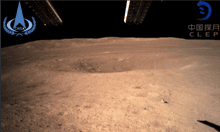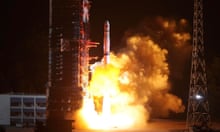China is one step closer to being the first country to land on the far side of the moon.
At 5.28am on Monday, the Queqiao relay satellite was launched from Sichuan province, according to Chinese state media. With Queqiao in place, China will be able to send a lunar probe to the side of the moon that never faces the Earth. No space programme has ever reached that part of the lunar surface because of communications difficulties.
In a few days Queqiao will enter the moon’s orbit, about 455,000km (282,000 miles) from Earth. Queqiao – which means “Magpie Bridge” and comes from a Chinese folk story in which an arc formed by birds reunites two lovers separated by the heavens – will then act as a bridge between ground stations and the lunar probe.China plans to send its lunar lander and rover, Chang’e 4, to the far side of the moon by the end of this year. The lunar probe will carry seeds for growing potatoes and arabidopsis, a flowering plant related to cabbage, for a “lunar mini biosphere” experiment.
“The launch is a key step for China to realise its goal of being the first country to send a probe to soft-land and probe the far side of the moon,” said Zhang Lihua, manager of the relay satellite project, according to state news agency Xinhua.
A four-minute video of the assembling of the rocket and satellite, accompanied by dramatic background music, was posted by state media outlets on social media on Monday. “My country is awesome,” one internet user wrote on Weibo. “Our conquest is the sea of stars.”
For the past decade, China has embarked on a space programme aimed largely at catching up to space powers such as the US and Russia. In 2013, China became the third country to make a soft landing on the moon.
Chinese space officials aim to attempt a human landing in 15 years. The China National Space Administration released a video in April showcasing its planned outpost, a “lunar palace” on the far side of the moon, with cabins for scientists.
Queqiao will also carry a radio antennae that researchers will use to study the early universe, what astronomers call the “cosmic dark ages” after the big bang and before the first stars in the universe were formed.
Being in the shadow of the moon blocks electromagnetic interference from Earth, offering a better view of radio signals in the universe and enabling researchers to “listen” to the cosmos, according to Liu Tongjie, deputy director of China’s Lunar Exploration and Space Program Center.






